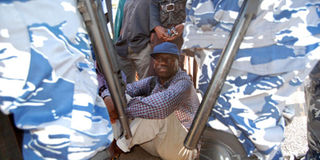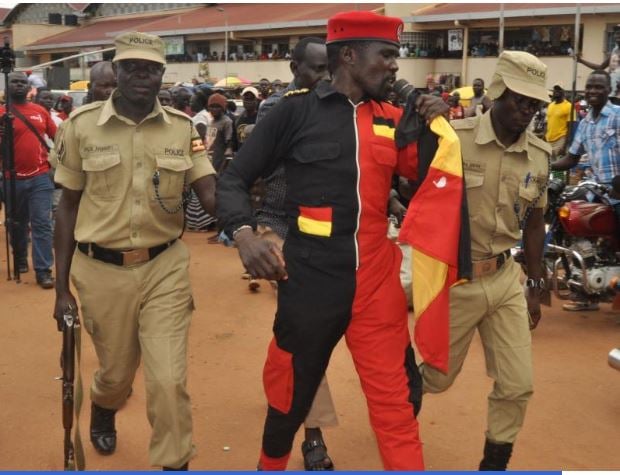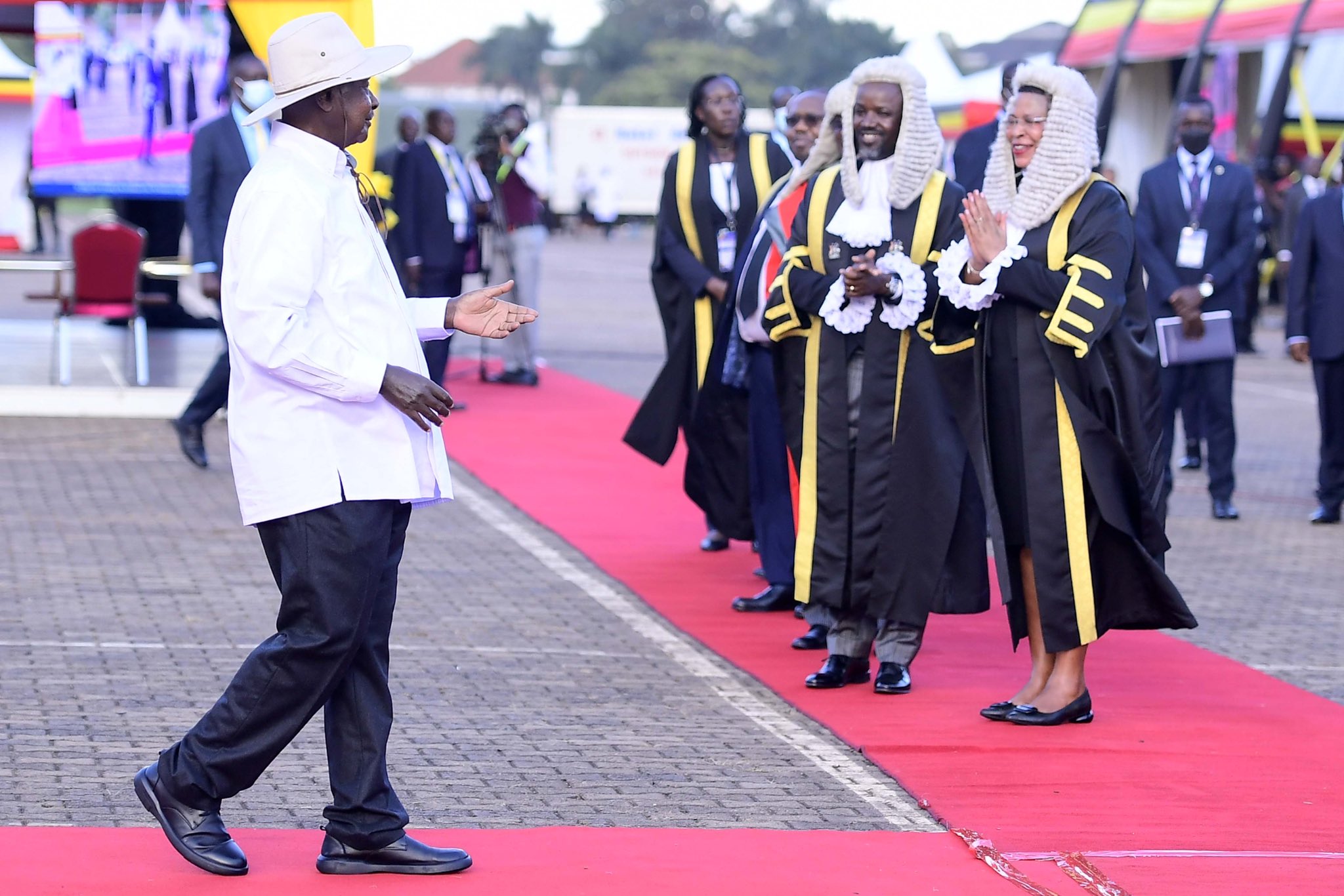How 2011 protests shook Uganda

Surrounded. Police officers block Dr Besigye during protests. File photo
What you need to know:
- One sided. Seven years ago this month, Uganda was shaken by the Walk-to-Work demonstrations.
- Lives were lost, suspects jailed, businesses destroyed, and the country’s reputation was damaged internationally.
- Organisers said the protests were to bring to attention the high food and fuel prices, after inflation hit double digits for the first time in more than a decade.
- State officials, on the other hand, accused Opposition leaders of attempting an Arab Spring-style uprising to topple the government.
- The demonstrations produced heroes and villains, as well as unpleasant surprises.
In an eight-part series starting today, Gillian Nantume conducted several interviews between January and April 2016 to look back into the events.
The 2011 General Election had been largely peaceful, but the main Opposition candidate Dr Kizza Besigye, who stood on the Forum for Democratic Change (FDC) party ticket, rejected the results as a “sham”. Instead of petitioning court like he did in 2001 and 2006, Dr Besigye vowed to take his cause to citizens, without clarifying how. And just under two months after the elections, the Walk-to-Work protests erupted, catching security agencies initially unaware.
The country’s political temperatures rose dramatically when long-serving leaders in North Africa were toppled through mass uprisings. Mr Yoweri Museveni, the incumbent president and National Resistance Movement (NRM) flag bearer, polled 68 per cent of the valid votes to secure a comfortable re-election. Opposition actors, who, prior to the campaigns, failed on a joint presidential candidate project, regrouped after the ballot to contrive how to make Uganda ungovernable.
Uganda Peoples Congress (UPC) party President Amb Olara Otunnu, one of the election losers, became the chief architect, chairing several strategy meetings in and outside his UPC party headquarters at Uganda House on Kampala Road.
International support for Uganda’s Opposition was, according to insiders, contingent upon them working together, and fronting one candidate. Going separate ways, therefore, fractured that anticipated compact and would-be external benefactors became unsure of how to proceed.
After weeks of rallies in the countryside, in which Amb Otunnu used the “Blue Book” to collect voters’ signatures to petition for electoral reforms, collaboration between the political parties and civil society organisations (CSOs) began building up. The Blue Book was later stolen at the peak of power feuding at Uganda House and Amb Otunnu, according to Democratic Party President-General Norbert Mao, then floated the idea of Walk-to-Work protests.
“As we were going through several options, Amb Otunnu threw an idea on the table,” says Mr Mao, himself a loser in the 2011 polls, adding, “He suggested we could abandon our cars and walk to work. We wanted to undress the government, which had failed to secure the economic interests of the people.”

Tormented. ASP Gilbert Arinaitwe (right) breaks the window of Dr Besigye’s car during the protests on April 28, 2011. File photo
A meeting to iron out the issues was held at Speke Hotel in Kampala. Dr Besigye skipped that meeting and never gave a reason. When addressing a rally in eastern Uganda, where police manhandled the former Assistant Bishop for Kampala, Zac Niringiye, the activists received news that Dr Besigye had begun a parallel Walk-to-Work demonstration in Kampala.
The government, recovering from the shock of the surprise 2009 pro-Buganda riots, responded with brute force. As the confrontations intensified, police and the military began preventing relatives from taking possession of dead bodies, sparking ugly fights over corpses. Unofficial estimates show that between 15-30 people were killed during the demonstrations, which spanned from April 2011 and ended on July 22, 2013.
In a March 2012 intelligence briefing prepared for President Museveni, the Chieftaincy of Military Intelligence (CMI) acknowledged that 12 people had been shot dead by security agencies. Asked by our reporter, during a press conference at the height of the protests, if he feared facing future trial, as the Commander-in-Chief, for the killing of civilians by security agencies, President Museveni said he hoped to be awarded the Nobel Peace Prize for managing Uganda “very well”, particularly the “army and the economy”.
The rationale of Walk-to-Work
Dr Besigye says the idea was to demonstrate on an economic matter that was affecting everyone. “We knew the demonstrations would be responded to enthusiastically. But we were also cognisant of the fact that the regime was not allowing public assemblies, both lawful and unlawful.”
Hon Francis Mwijukye (Buhweju County), who was Besigye’s aide, argues that the people’s economic plight did not sit well with the Opposition. “People had parked their cars (because of the high cost of fuel). They could not even afford taxis. They were walking to town. We asked ourselves why we couldn’t join them. So we walked – as a protest and in solidarity with masses.”
Lord Mayor Erias Lukwago, says, “Of course, there were issues to do with the elections. There was disenchantment and disillusionment, but we designed it (Walk-to-Work) in such a way that we were protesting against the economic crisis.”
Perhaps, news that the government was planning to spend $740m (Shs2.6trillion) on a squadron of Sukhoi Su-30 multirole fighter jets from Russia played a role. Also, despite the soaring commodity prices, $1.3m (Shs4.673billion) had been set aside for the president-elect’s swearing-in ceremony.
“Walk-to-Work was, for once, a protest not aimed at overthrowing the government politically,” says Mao, adding, “With the galloping inflation, it was useful in highlighting the economic agony people were facing. The government was saying there was economic prosperity so our purpose was to unmask it (government).” He adds that inspiration for the protests came from the Arab Spring.
However, Col Felix Kulayigye, UPDF Political Commissar, disagrees. At the time of Walk-to-Work, he was the UPDF spokesman. “Opposition politicians had hoped to make a coup through Walk-to-Work. There was a protest against sugar prices and then, there was also a protest against the elections. They were exploiting every opportunity to head to State House, because if you are protesting economic conditions, you go to Parliament.”
Kulayigye adds that economic protests do not need Opposition politicians to lead them because they concern issues of the stomach. “Walk-to-Work was an attempted coup. What Dr Besigye had failed to achieve in the election, he hoped to achieve Tahrir-style. I found these politicians detached from reality because to think that the Arab Spring was possible here was simply day-dreaming.”
“Political and economic protests cannot be separated,” Dr Besigye argues, adding, “The inflation was caused by huge amounts of money distributed by the regime during the campaigns. People were already walking to work, anyway.”
Were the protests legal?
Dr Kabumba Busingye, a constitutional lawyer and law don at Makerere University, says under Article 29 of Uganda’s Constitution, citizens have right to peacefully demonstrate, “in so far as the Walk-to-Work protests did not involve a danger to lives and property and were done voluntarily. Balancing the rights of protestors and public safety was a major issue. The Constitutional Court pronounced itself in Muwanga Kivumbi vs the Attorney General (Constitutional Petition No.9/2005). Justice (Constance) Byamugisha noted (in a judgement given on May 27, 2008) that any democratic society will have people with different views who want change, and a democratic society should, as far as possible, allow for the expression of those views.”
In her ruling, Justice Byamugisha said, In every society there is always tension between those who desire to be free from annoyance and disorder on one hand to (sic) those who believe to have the freedom to bring to the attention of their fellow citizens matters which they consider important. Peaceful assemblies and protests are a vital part of every society. They can be a very powerful tool…The right to peaceful protest is not absolute. The police have a wide range of powers to control and restrict the actions of protestors. These powers should not be exercised by the police in an unaccountable and discriminatory manner.
Ladislaus Rwakafuzi, a lawyer and human rights advocate, says, “You must tell the public why you are protesting. Of course, the public will never be behind you 100 per cent, but even those who do not support you should not get in your way. Those protesting should be protected by the police.”
However, the rights of the protesters and the consequences of the protests are two different things. “In my opinion, there were no riots during the Walk-to-Work campaign,” says Rwakafuzi, continuing, “What actually happened is that the police rioted. They stopped people who were lawfully exercising their rights, imposed their will on them, and tear-gassed them.”
Col Kulayigye agrees that demonstrations are legal, however, he stresses that once they turn into riots it becomes a security matter. “Riots endanger national security just like terrorism and insurgency. We do not live in a jungle. There are rules and regulations, and the State is an arbiter. That is why before you go on the streets, you must tell the police your intentions so that they guide and protect you, and protect those who are not part of your protest.”

In tears. Pupils of Wampewo Primary School cry after their school was teargased by military police.
Beginning of Walk-to-Work
On April 8, 2011, Masaka Municipality MP-elect, Mathias Mpuuga, at Fairway Hotel in Kampala, announced the formation of a pressure group, Activists for Change (A4C). The plan was to walk every Monday and Thursday. Dr Besigye soon emerged as the face of the protests. Mwijukye would go to Besigye’s home in Kasangati every morning. “In the evening, a police patrol car followed me home. In the morning the same car followed me back to Kasangati. This escort is what made Walk-to-Work famous.
On April 11, 2011, Besigye left his home on foot. He was intercepted by police, arraigned before Kasangati Magistrates Court for committing traffic offenses and inciting violence. Other Opposition figures were also intercepted as they left their homes.
As expected, residents of Benghazi (from Luteete to Gayaza), were the first victims. St John XXIII Health Centre II is located in a quiet neighbourhood. The expanse of land in front of it serves as a parking lot. Seven years ago, it was a mini forest which drug addicts had claimed.
“We could smell the marijuana in the hospital,” says Dr Charles Luzige, the medical officer, adding, “There were many cases of rape and strangulation (of passers-by) in that place.”
These idlers welcomed the chance to stone the police. As Dr Besigye was being arrested, it was business as usual at St Kizito Bishop Mukwaya Primary School, which is sandwiched between Gayaza market, St John Health Centre and Our Lady of Good Counsel Church.
Suddenly, gunshots rang out, shuttering the quiet. Teachers cautiously walked to the verandas. The headmistress, Winifred Nakimwero Mpagi, vividly recalls the day. “Pupils started moving out of the classes. We saw people running towards the school; so, I told the students to converge in the compound.”
The classrooms are less than 100 metres from the gate. Sections of the fence were missing so the fleeing rioters entered the school. “We saw policemen chasing people and thought that if the children gathered in the compound, the police would see them and realise this is a school. To our surprise they threw three teargas canisters into the compound. The children screamed and scampered for safety.”
Teachers pouring water on the crying and fanned the unconscious. Market vendors, many of whom have children in the school, were watching the action. “The vendors run to the gate, shouting, ‘Teacher Winnie! Give us our children!’ I told the askari not to let them in.”
Some protestors sought refuge in the hospital compound. Dr Luzige says, “We had pregnant women and young children in the hospital but we were tear-gassed. The staff fled, abandoning patients. Some of us ran to the school to offer first aid.”
Realising their mistake, the police entered the school and apologised. “They claimed not to know this was a school because they were just following rioters,” Mpagi says.”
By 3am, the situation had normalised, and 20 pregnant women were referred to Nagalama Health Centre and Mulago Hospital. Two days later, (then) police spokesperson, Judith Nabakooba, visited the school and offered another apology. She also visited the hospital with juice and tinn ed food. That day, (then) Police Political Commissar Asan Kasingye, outlawed the next protest. The A4C ignored him.




